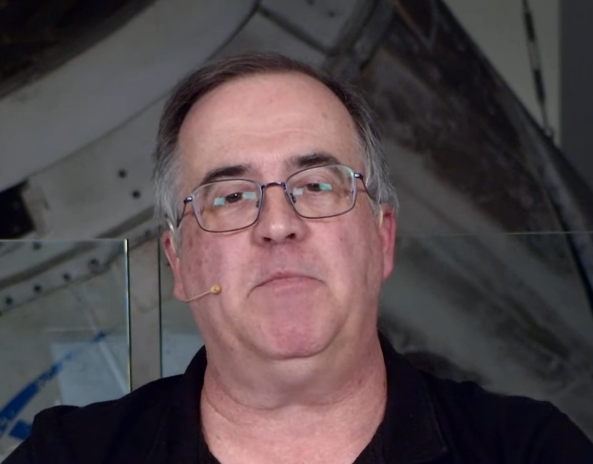

Yeah. One possibility is that SpaceX were indeed underperforming, and the story was placed to put public pressure on them to improve. (A bit like the 2019-09-27 Bridenstine tweet.)


Yeah. One possibility is that SpaceX were indeed underperforming, and the story was placed to put public pressure on them to improve. (A bit like the 2019-09-27 Bridenstine tweet.)


(And just to be clear, I have many problems and potential concerns about Musk. I’m just saying I’d choose him over, say, a Maoist, or a Stalinist, and over “Burn_The_Right”.)


How do we remove this cancerous cyst?
I think your username gives us a clue what you would do to Musk and others if you ever gained any power.
I would entrust the wellbeing of humanity to him, over you, without hesitation. We had enough of your type in the 20th Century, thanks.


I’m sure he could block the Starlink terminals Russian army is using, if he wanted to try, for example.
I remember a story coming out about Russians using Starlink but it seemed a bit vague to me. Has anyone reliable actually asserted that SpaceX are significantly underperforming in the job of blocking captured terminals (once notified), or other aspects of the day-to-day operations that the Ukrainians would do if they controlled it themselves?


Though at least they’ve already proved they can relight during a belly flop.
I would not have thought it could float in a different orientation
Me either. But they call that orientation “Stable 1”, possibly implying they’ve accounted for other stable orientations, and some non-stable situations.
Here was the first time I heard that term (with Bob & Doug): https://www.youtube.com/live/tSJIQftoxeU?t=6h29m34s
The commentator then gives some explanation.
Post-splashdown news conference: https://youtu.be/gOUoI-UYi2Y
They mentioned that Cargo Dragon sometimes reuses parachutes, which I didn’t know.
Watched some of the official coverage: https://www.youtube.com/live/5CRB3FHV9Dw
Things that were new to me:
And all this talk of Dragon orientation, combined with the extensive weather delays in Crew-8’s departure, got me wondering … How would Dragon fare if it was left in very rough seas for an extended period? (Imagine the recovery vessel broke down a minute after splash-down and then a big multi-day storm blew in, or something.)


Plausible. It’s not how I imagine them engaging with their defence contractors but I don’t actually have a clue how it works. One supporting point might be if there were any other companies treated similarly, like if Lockheed Martin was ordered to immediately ramp up production of relevant types of military hardware, and told that the details (contracts / payment / etc.) would be sorted out later.
An opposing point would be the fact that the US and its allies knew an invasion was likely well in advance. Yet the initial Starlink ‘roll out’ seemed pretty ad hoc, with SpaceX organizing its own logistics. But then maybe the allies didn’t expect Russia to be so effective in disrupting the existing military comms infrastructure.


that the engines relight multiple times in orbit
Should they do an orbital test next? Or continue with the previously used ‘almost orbit’ trajectory that ensures the second stage re-enters safely with no need for a relight?


The SpaceX officials in the audio said they were “trying to focus on booster risk reduction versus ship envelope expansion” for the next flight.
For the “ship envelope expansion”, do you think they will/should do an in-space engine relight test? Or are the seemingly successful flip-landing maneuvers on flights 4 and 5 sufficient? (Has this been covered elsewhere?)


Interesting! They’re talking about unnecessary aborts, and how they want to do as much analysis as possible of the abort criteria, to prevent them.
This will remain an issue for Flight 6 which, it seems, will happen the moment SpaceX decides it’s sufficiently ready. Unlike previous flights …
“Given this is the first launch in a long time … well really ever … that we’ve not been FAA driven …”


This would be a nuclear option and, in reality, probably would do more harm than good to SpaceX,
It would probably set back their more ambitious targets by decades. But even Starship is now far enough along to no longer really need Musk’s stewardship, and the US government would be happy enough just with control of the Falcon programme. They don’t care much / at all about Making Life Multi-Planetary.
So I consider a move like this pretty plausible.


If so, why would SpaceX have so rapidly & aggressively moved to restore Ukraine’s communications capabilities in the early days and weeks of the current war, and maintained them ever since?


I find the defendant not guilty! I think the NSF guy’s idea involved replacing the woman & her arms and the daughter with the tower & “chopstick” arms, and a Super Heavy rocket booster (which is in the process of being caught by the arms). Something like that?
The closest I’ve seen is this. Not great!
So I tried getting Chat GPT to do a better one for me. This did not go well 😂 But surely someone with experience should be able to cajole a suitable generative AI tool to do a good job of it?


One of my favourite videos of the catch, because of what happens when the sonic booms arrive!: https://youtu.be/749dRxbSkVU (They’re at 6:51.) Also it’s a different angle from most of the others, because it’s from Mexico.
And a playlist: Starship IFT5 booster catch, original footage only


You heard it on Lemmy first!: https://sh.itjust.works/post/25840892 (very soon after Stich first mentioned it)


Link currently doesn’t WFM.
I believe when you create a clip from an ongoing YouTube live stream, it will (at best) only work as long as the footage you selected is still available on the stream. And I believe YouTube only keeps the most recent 12 hours of footage.
(What they should do is create a permanent copy of the relevant footage, assuming the channel owner permits it.)


The fairing looks spotless. I guess they’re using a new one, at least partly for reasons of cleanliness? (Planetary protection and all that.)
With boosters we’re at the point where “flight proven” is no longer just a euphemism for “second hand”. I’ve felt that way myself for a few years. And NASA basically confirmed they agree a couple of months ago, when the brand new booster intended for Crew-9 was given a Starlink mission first, increasing confidence in it after a minor problem during transport. (IIRC)
But I’m not sure if we’re at that point with fairings. Or even if we’ll ever be.
Just saw this https://x.com/SpaceX/status/1849956344691912873